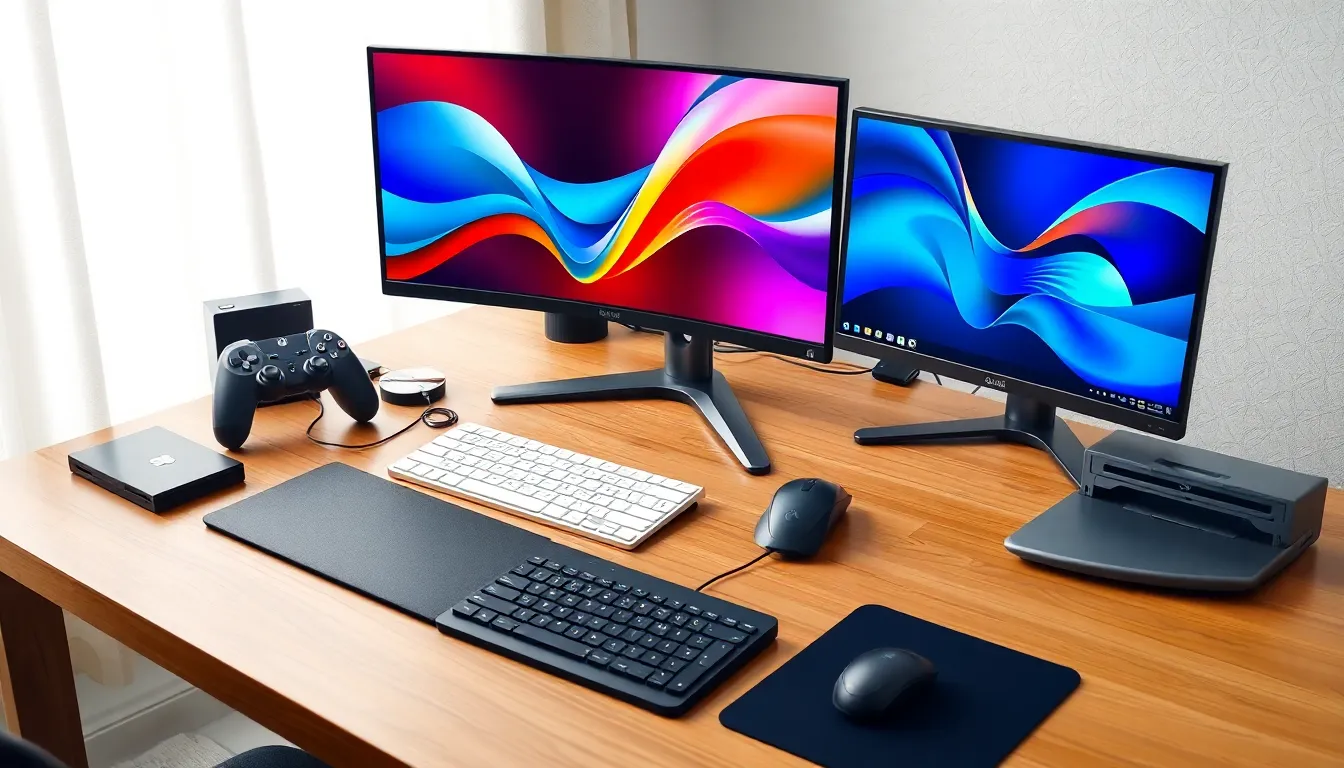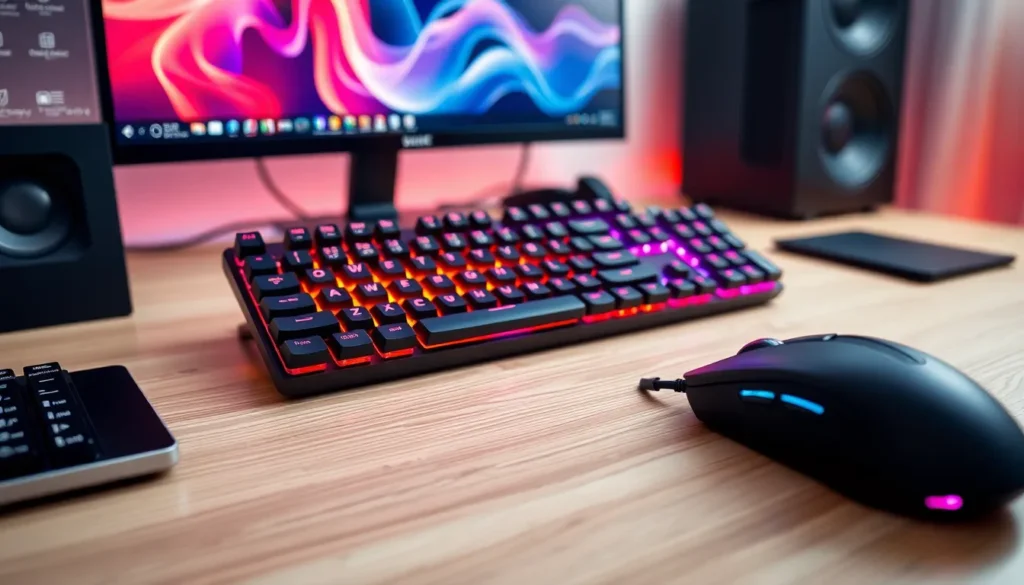In a world where computers are the brains, computer peripherals are the charming sidekicks that make everything run smoothly. From keyboards that click like a satisfied sigh to mice that glide as effortlessly as a cat on a sunny windowsill, these gadgets are more than just accessories—they’re essential partners in the digital dance.
Table of Contents
ToggleOverview of Computer Peripherals
Computer peripherals are devices that connect to a computer, enhancing its overall capabilities. Common examples include keyboards, mice, printers, and scanners. Each peripheral plays a unique role in improving user interaction and productivity.
Keyboards allow users to input data and control the computer, making them fundamental tools. Mice facilitate navigation, enabling precise movement across the screen. Both devices have evolved, with options like mechanical keyboards and ergonomic mice catering to various preferences.
Printers serve to produce physical copies of digital documents, while scanners offer the ability to digitize printed materials. These peripherals streamline workflows in office settings and home environments alike.
Storage devices, including external hard drives and USB flash drives, offer additional capacity for data storage and transfer. Users can expand their system’s memory easily and back up important information securely. Networking peripherals, such as routers and modems, connect computers to the internet, allowing for seamless online communication and access to resources.
Audio peripherals, including headphones and speakers, enhance multimedia experiences. They contribute to sound clarity during video calls, music playback, and gaming sessions, enriching the overall interaction.
Choosing the right combination of peripherals can significantly impact efficiency and comfort. Each component plays a vital role in creating a cohesive and effective computing environment.
Types of Computer Peripherals

Computer peripherals enhance computer functionality, making interaction more intuitive and efficient. Various types of peripherals play unique roles in this process.
Input Devices
Input devices capture user commands and data. Keyboards serve as essential tools for text entry, while mice facilitate navigation and interaction within digital environments. Touchscreens offer an alternative method for input through direct finger interaction. Game controllers cater specifically to gaming by providing an immersive experience. Scanners allow users to digitize physical documents and images. Each of these devices improves how individuals interact with computers.
Output Devices
Output devices convert computer data into usable information. Monitors display visual content and allow users to view tasks or media. Printers provide tangible copies of digital documents, vital for business and personal use. Speakers produce audio output, enriching multimedia experiences with sound. Projectors extend visual content to larger screens for presentations or entertainment. By facilitating data presentation, output devices are crucial for effective communication.
Storage Devices
Storage devices expand computer data capacity and retention. Hard disk drives (HDD) and solid-state drives (SSD) store operating systems, applications, and user files. USB flash drives offer portable storage solutions, useful for transferring data between devices. External hard drives serve as backups, protecting against data loss. Cloud storage services provide remote access to files from any device with an internet connection. Each option ensures users can efficiently manage and secure their data.
Popular Computer Peripherals
Computer peripherals enhance the functionality of computers, making them integral to daily tasks. Various devices cater to user needs, promoting efficiency and comfort.
Keyboards
Keyboards serve as essential input devices for data entry. Users rely on mechanical, membrane, and ergonomic keyboards to suit their preferences. Mechanical keyboards provide tactile feedback, ideal for typists and gamers. Membrane keyboards often offer a quieter experience, suitable for office environments. Ergonomic keyboards reduce strain during long typing sessions by promoting a more natural hand position.
Mice
Mice play a crucial role in navigation and interaction with computers. Options range from optical mice to trackball and gaming mice. Optical mice track movement accurately on various surfaces, while trackball mice provide precision without needing desk space. Gaming mice often feature customizable buttons and enhanced sensitivity, catering to gaming enthusiasts. Each type of mouse addresses specific user needs, improving overall productivity.
Printers
Printers are essential output devices that convert digital documents into physical copies. Inkjet and laser printers dominate the market, each offering unique benefits. Inkjet printers excel in producing high-quality images and photos, making them popular for home users. Laser printers provide faster printing speeds and cost-effective bulk printing, commonly used in business settings. Depending on user requirements, printers significantly enhance workflow efficiency.
Choosing the Right Computer Peripherals
Choosing computer peripherals requires consideration of specific needs and preferences. Users benefit from a thoughtful selection, which enhances overall performance and comfort.
Factors to Consider
Compatibility ranks high when selecting peripherals. Ensure devices connect effortlessly to the computer’s operating system. Purpose drives the choice; gamers might prefer high-DPI mice while office workers prioritize ergonomic keyboards. Portability may also matter for users on the go. Evaluate durability for long-lasting performance. Adjustability features in items like chairs or monitors contribute to user comfort. Cost effectiveness should influence decisions; assess quality against the budget.
Brand Recommendations
Logitech consistently earns praise for high-quality mice and keyboards. Razer specializes in gaming peripherals, catering to serious gamers with advanced features. Corsair offers customizable options, appealing to both gamers and professionals. Dell provides reliable performance across various product lines. HP stands out with versatile printer solutions suitable for home and office use. Each brand presents unique strengths, so users should identify which aligns best with their needs.
The right computer peripherals can transform the way users interact with their devices. By enhancing functionality and comfort they play a crucial role in productivity. From choosing the perfect keyboard and mouse to selecting the ideal printer or storage solution each peripheral contributes to a more efficient computing experience.
Investing in quality peripherals tailored to individual needs not only improves performance but also ensures a seamless workflow. As technology continues to evolve staying informed about the latest peripherals will help users make choices that best suit their requirements. Ultimately the right combination of devices can elevate any computing setup making tasks more enjoyable and efficient.




